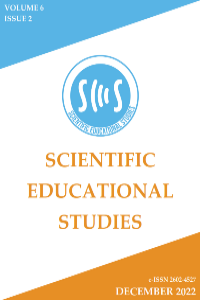Öz
In this article, the 19-item information dimension of the scale, originally named "Sustainability Consciousness Questionnaire", was developed by Michalos, Creech, Swayze, Kahlke, Buckler & Rempel (2012) and updated by Gericke, Pauw, Berlung & Olsson (2018), whose factor structure was previously revealed. (latent variable) Construct validity was tested by applying it to a new data set of 307 people. IBM SPSS and AMOS statistical package programs were used in the analysis of the data. According to the results obtained in the study; It was found that the information dimension of the scale was gathered under three factors as in the original and it could explain 61.72% of the total variance. As a result of the reliability analysis, it was determined that the scale had a high level of reliability according to the Cronbach's-α coefficient (Cronbach's-α =0.923). In the confirmatory factor analysis, the improvement in the goodness of fit coefficients was examined by controlling the modification indices. In addition, the path coefficients of how much the 19 items belonging to the first level of the scale predict the latent variable are all significant. Among the items, it was found that the 13th and 14th items had the most effect (β1= 0.828, p<0.01).
Anahtar Kelimeler
Goodness of Fit Indices Structural Equation Modeling Factor Analysis.
Kaynakça
- Anderson, J.C., Gerbing, D.W. (1984). The effect of sampling error on convergence, improper solutions, and goodness-of-fit indices for maximum likelihood confirmatory factor analysis, Psychometrika, 49(2),155–173.
- Bartlett, M.S. (1950). Test of significent in factor analysis, British Journal of Psychology, Statistical Section, 3,77-85.
- Byrne, B.M. (2009). Structural equation modeling with AMOS: basic concepts, applications and programming. London: Taylor & Francis Group.
- Cronbach, L.J. (1951). coeffıcient alpha and the ınternal structure of tests, Psychometrika, 16(2), 297-334.
- George, D. and Mallery, M. (2010). SPSS for Windows step by step: a simple guide and reference. Boston: Pearson.
- Gerbing, D.W. and Anderson, J.C. (1993). Monte Carlo evaluations of goodnessof-fit indices for structural equation models. K.A., Bollen and J.S., Long (Ed.), Testing structural equation models Pp.40–65. USA: Sage publication. Gericke, N., Boeve‐de Pauw, J., Berglund, T., Olsson, D. (2019).The Sustainability Consciousness Questionnaire: Thetheoretical development and empirical validation of an evaluation instrument for stakeholders working with sustainable development. Sustainable Development, 27(1), 35-49.
- Harrington, D. (2009). Assessing confirmatory factor analysis model fit and model revision. New York: Oxford University Press.
- Hooper, D., Coughlan, J.,and Mullen, M.R, (2008). Structural equation modelling: guidelines for determining model fit, The Electronic Journal of Business Research Methods, 6(1), 53-60. Hu, L.T.& Bentler P.M. (1995). Evaluating model fit. R.H., Hoyle (Ed.). Structural equation modeling: Concepts, issues and application Pp. 77-99. USA: Sage publication.
- Hu, L.T. & Bentler, P.M. (1999). Cutoff criteria for fit ındexes in covariance structure analysis: conventional criteria versus new alternatives structural equation modeling: A Multidisciplinary Journal, 6(1), 1-55.
- Jöreskog, K.G. (1967).A general approach to confırmatory maxımum lıkelıhood factor analysıs.ETS Research Report Series,1967(2),183-202. Jöreskog, K.G. & Sörbom, D. (1993). LISREL 8: Structural equation modeling with the SIMPLIS command language. Chicago: Scientific Software International.
- Kelloway, E.K. (1998). Assessing model fit. using lisrel for structural equation modeling. USA: Sage Publications.
- Kline, R.B. (2011). Hypothesis Testing: Principles and Practice of Structural Equation Modeling. New York: The Guilford Press.
- Marsh, H.W., Balla, J.R. and McDonald R.P.(1988). Goodness-of-fit indexes in confirmatory factor analysis: The effect of sample size, Psychological Bulletin, 103(3), 391–410.
- Michalos, A. C., Creech, H., Swayze, N., Kahlke, M., Buckler, C., Rempel, K., (2012). Measuring knowledge, attitudes and behaviors concerning sustainable development among tenthgrade students in Manitoba. Social Indicators Research, 106(2), 2013–2038,.
- Özdamar, K. (2004). Tabloların Oluşturulması, Güvenirlik ve Soru Analizi. Paket Programlarla İstatistiksel Veri Analizi-1. Eskişehir: Kaan Kitabevi.
- Pallant, J. (2002). SPSS Survival Manual: A Step by Step Guide to Data Analysis Using IBM SPSS. London: Routledge.
- Tabachnick, B.G. & Fidell, L.S (2001). Using Multivariate Statistics. Boston: Allyn and Bacon.
- Tanaka, J.S. (1993). Multifaceted conceptions of fit in structural equation models. J.A.,Bollen, and J.S., Long (Ed.). Testing structural equation models Pp. 10–39. USA: Sage Publictaion.
- Tuğrul, F., Çitil, M., Karasolak, B., Dağlı, M. (2020). Interpretation of Physical Conditions of Schools with Fuzzy Multi Criteria Decision Making, Journal of Universal Mathematics, 3(1), 46-52.
- Tuğrul, F., Çitil, M., A (2021). New perspective on evaluation system in education with ıntuitionistic fuzzy logic and promethee algorithm. Journal of Universal Mathematics, 4(1), 13-24.
- Yüksel, Y. & Yıldız, B. (2019). Adaptation of sustainability consciousness questionnaire. Erciyes Journal of Education, 3(1): 16-36.
Ayrıntılar
| Birincil Dil | Türkçe |
|---|---|
| Bölüm | Makaleler |
| Yazarlar | |
| Yayımlanma Tarihi | 15 Aralık 2022 |
| Yayımlandığı Sayı | Yıl 2022 Cilt: 6 Sayı: 2 |

